The second of two Spring Migration Tours in North Norfolk. Today was meant to be luckier than yesterday, according to superstition, but we actually just had another great day. It was a bit brighter, but still cold in a blustery northerly wind on the coast.
We stopped first just inland from the coast and walked up a quiet country lane where we were out of the worst of the wind. There were lots of birds singing – a Song Thrush in the trees, a couple of Chiffchaffs, a Sedge Warbler sheltering in the hedge and several Blackcaps. A Common Whitethroat hopped up in front of us.
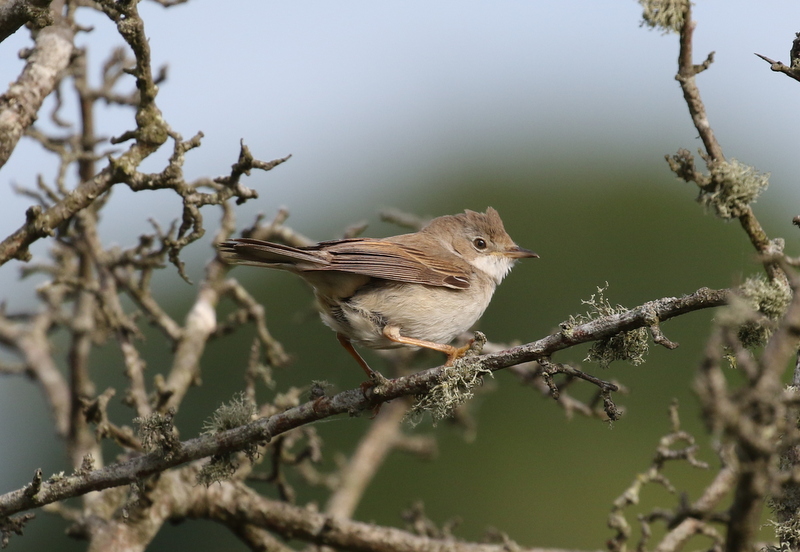 Common Whitethroat – one of several warblers in the hedges
Common Whitethroat – one of several warblers in the hedges
A Cetti’s Warbler shouted at us from the bushes as we passed. Not content with surprising us once, it then flew ahead of us and sang at us repeatedly as we walked along. For once, we got to see it as it flew, its deep chestnut back and rounded tail. We could hear Bullfinches calling from the hedge ahead of us, and a bright pink male appeared on the edge, followed by a duller female. They didn’t stay long, but flew off piping – there were actually three of them, as a second female appeared too. A Green Woodpecker laughed at us from the trees.
We had come here to listen to the Nightingales, but they were a bit slow to get going. We heard a croak and a few notes at one point, but they were then all drowned out by a Song Thrush which started singing instead. We gave up and walked a little further along, and when we returned the Nightingale finally started singing a little more. We followed it alongside the dense bushes as it moved along, and eventually got a brief look at it as it flicked out of the brambles and flew along the hedgerow. That was a great way to start to the day, listening to Nightingale singing. Back at the car, lots of House Martins were hawking for insects in and out of the trees.
Given the blustery wind, we decided to head inland to Felbrigg Park, which should be a little more sheltered. Lots of Sand Martins and Swifts had the same idea, with a few House Martins thrown in for good measure, and were flying round low over the grazing meadows or in and out of the edge of the trees. There were loads over the lake too, and we walked up just in time to see a Hobby stoop down and scythe through them. It didn’t catch anything, but after a couple of passes it turned away and disappeared over the trees. A few seconds later, it reappeared with a second Hobby and started to buzz the edge of the wood. All action stuff!
We had hoped to find the pair of Garganey which have been here for more than two weeks now. There was no sign of them on the flooded grazing meadow, but as we walked out beside the lake we saw the drake in amongst the trees in the edge of the water. He swam out and we got a good look at him through the scope, before he swam back in again and climbed out onto a tree trunk.
At that point, we spotted the pair of Mandarin Ducks on the other side of the lake. They were very close to the wall, obviously feeding on insects which had been blown over to that side by the blustery wind. We hurried over and had a great view of them feeding quietly along the edge.
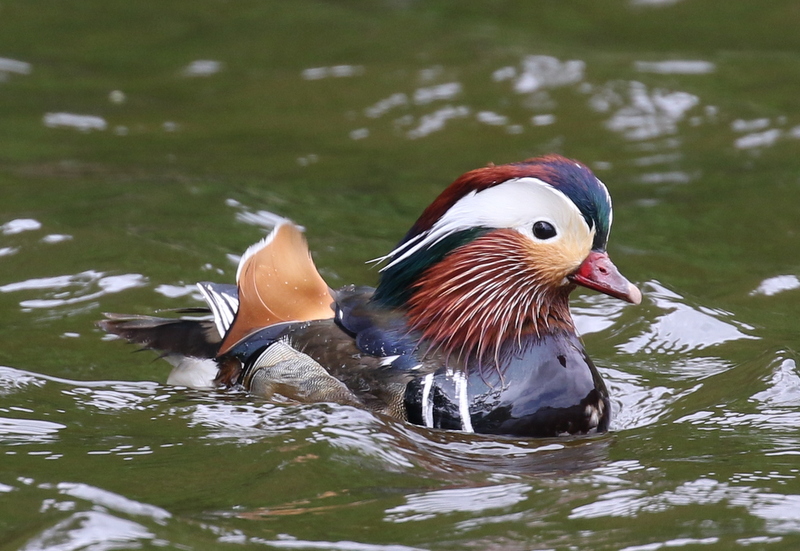
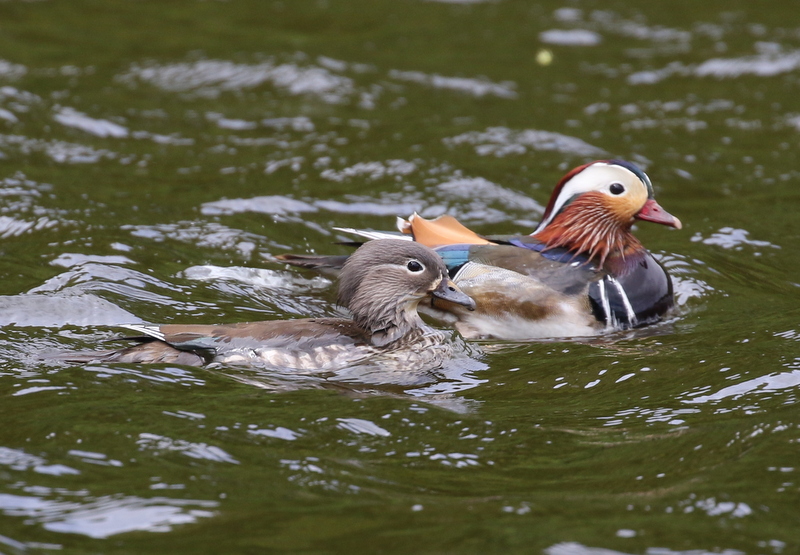 Mandarin – a pair were feeding right along the edge of Felbrigg Park Lake
Mandarin – a pair were feeding right along the edge of Felbrigg Park Lake
There were a couple of Common Sandpipers around the lake too. They seemed to be trying to rest on the branches and tree trunks along the west side, but kept getting spooked and flying round low over the lake. We worked our way round that side, along the path through the trees, and from the viewing screen we could see the drake Garganey asleep on its favourite tree trunk. When something spooked it, it dropped down into the water behind, but then immediately climbed back up to where it had been resting and we had a quick look at it through the scope before it went back to sleep.
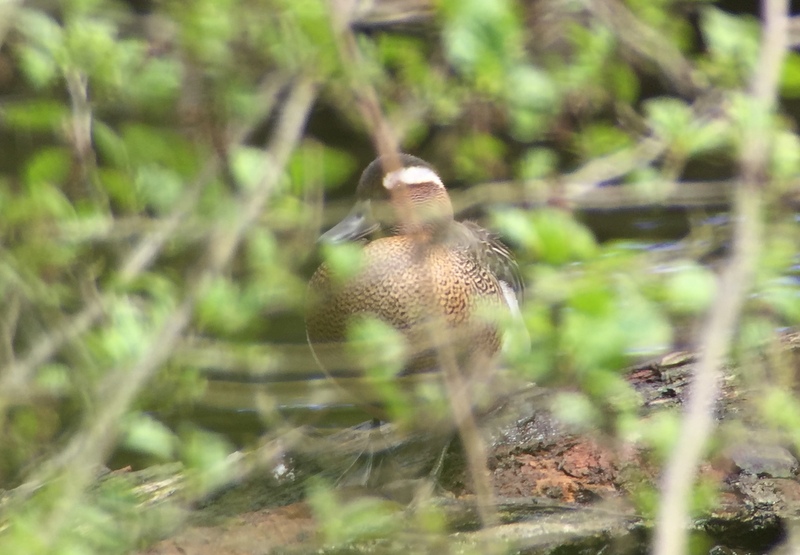 Garganey – the drake spent most of his time asleep on a trunk
Garganey – the drake spent most of his time asleep on a trunk
As we walked back to the car, a Common Buzzard drifted overhead, over the clearing. Then, from a small stand of fir trees, we heard a Firecrest singing. We could just see it flicking around among the branches close to the trunk at first, but gradually it came out more into the open, though it was still hard to follow. We could see its more strongly marked face pattern than a Goldcrest, all black and white stripes!
 Firecrest – singing from some fir trees on our way back
Firecrest – singing from some fir trees on our way back
We had an early lunch at Felbrigg. A Jay flew in to a tree just behind us. We could hear a Treecreeper calling and a couple of Siskins flying overhead. After lunch, we started to make our way back west.
Our next stop was at Kelling, where we had a quick stroll down to the Water Meadow. As we walked, several warblers were singing from the hedges – a Blackcap or two, a Chiffchaff and several Common Whitethroat. Down at the pool, the pair of Egyptian Geese were still tending to their four fast-growing goslings. The drake continues to chase off all other wildfowl, which obviously pose a grave and present danger to his offspring! A single Common Sandpiper had escaped his attention and was feeding quietly around the margin.
We had seen a flock of Linnets flying around at Felbrigg earlier, but one of the group wanted to see one better. Fortunately, Kelling is a great spot for them and we had several perching up in the brambles and down on the grass in front of us.
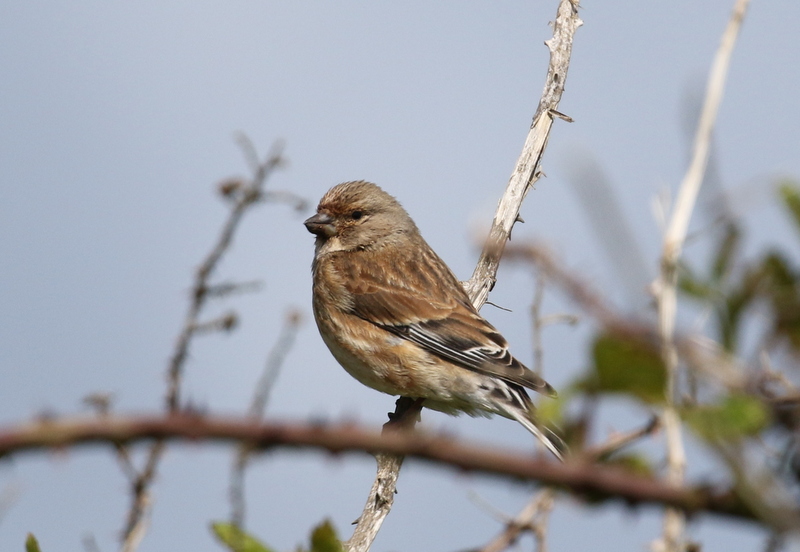 Linnet – there are always plenty at Kelling
Linnet – there are always plenty at Kelling
We had a quick walk round the Quags and up the hill beyond, although it was very windy up there so we beat a hasty retreat. We did come across a pair of Stonechats taking food into the bushes and another lone male whose mate is presumably still sitting on eggs. There are lots of Meadow Pipits here too and a Sedge Warbler sang from deep in the brambles, sensibly keeping out of the wind.
 Stonechat – we saw several at Kelling
Stonechat – we saw several at Kelling
We finished the day at Cley. We had a quick look at Pat’s Pool from the visitor centre, and there appeared to be little of note out on the scrape – plenty of Avocets, Redshank and a single Greenshank. There were lots of Swifts hawking for insects over the reserve, presumably migrants stopping off on their journey, and quite a few Sand Martins which were more likely local birds. There was very little in the sightings book or on the board for today either, so we elected not to venture out to the hides. The pools from the East Bank have been much more productive recently, so we decided to walk round there instead.
As soon as we got up on the East Bank, we could immediately see a Spoonbill feeding out on the furthest bit of the Serpentine, so we hurried up there straight away. On the way, we noticed there was a second Spoonbill there too. At first the two were feeding separately, but then they joined up and we were treated to a bit of synchronised Spoonbill feeding action!
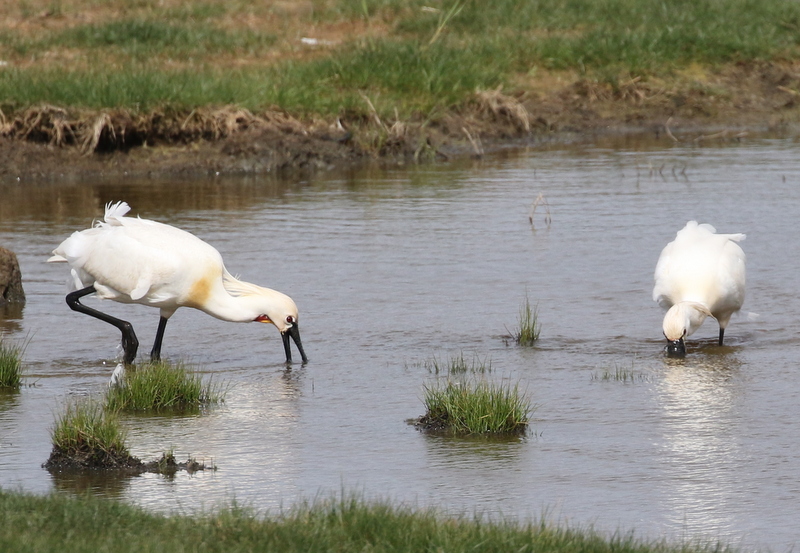

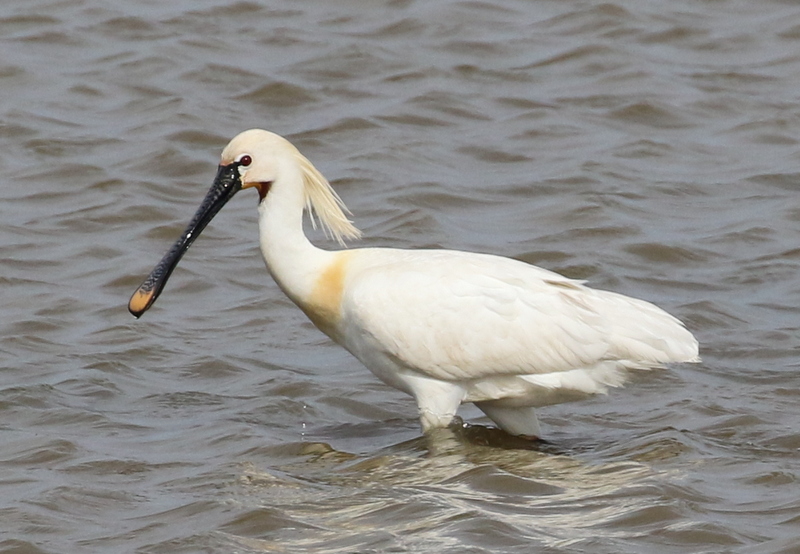 Spoonbill – these two were feeding together on the Serpentine
Spoonbill – these two were feeding together on the Serpentine
We spent a bit of time watching the two Spoonbills, and they gradually worked their way closer. Eventually we were treated to great close-up views of them, sweeping their bills vigorously side to side through the shallows looking for food. Occasionally one or other would flick its head up as it caught something. Then a noisy crowd started to gather on the East Bank and they moved further away.
There were other birds out on the Serpentine and Pope’s Marsh too. A smart male Ruff, with a very white ‘ruff’, presumably what is known as a ‘satellite male’ (in reference to the complex different breeding strategies of the various males) was feeding quietly along the muddy water’s edge. We found a couple of Little Ringed Plovers too – we could see the golden eyering on the closer one. There were two Common Sandpipers bobbing their way around on the mud. A pair of Gadwall were upending in the water. A Marsh Harrier quartered over the reeds the other side.
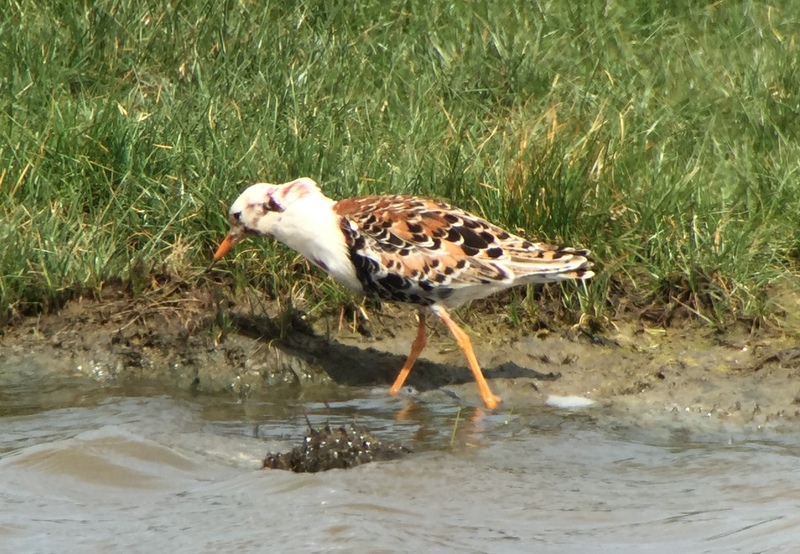 Ruff – with a striking white ‘ruff’
Ruff – with a striking white ‘ruff’
Arnold’s Marsh has been full of waders in recent days, but was surprisingly quiet today. Perhaps the wind had forced most of the birds to feed elsewhere today. There were still a good number of Redshank and a few Avocet. Otherwise, a single Ringed Plover was the best we could manage on here today. A few Sandwich Terns flew over, presumably on their way back to Blakeney Point to roost, after a busy day fishing along the coast.
We had a more leisurely walk back. The grazing marshes are kept much wetter these days and that is great for breeding waders. We could see several very cute baby Lapwings out on the small muddy pools, with a parent standing guard nearby. A couple of Little Egrets were fishing in the shallow pools. Looking over to Snipe’s Marsh, a Little Grebe was diving constantly. Then it was time to make our way back.
















